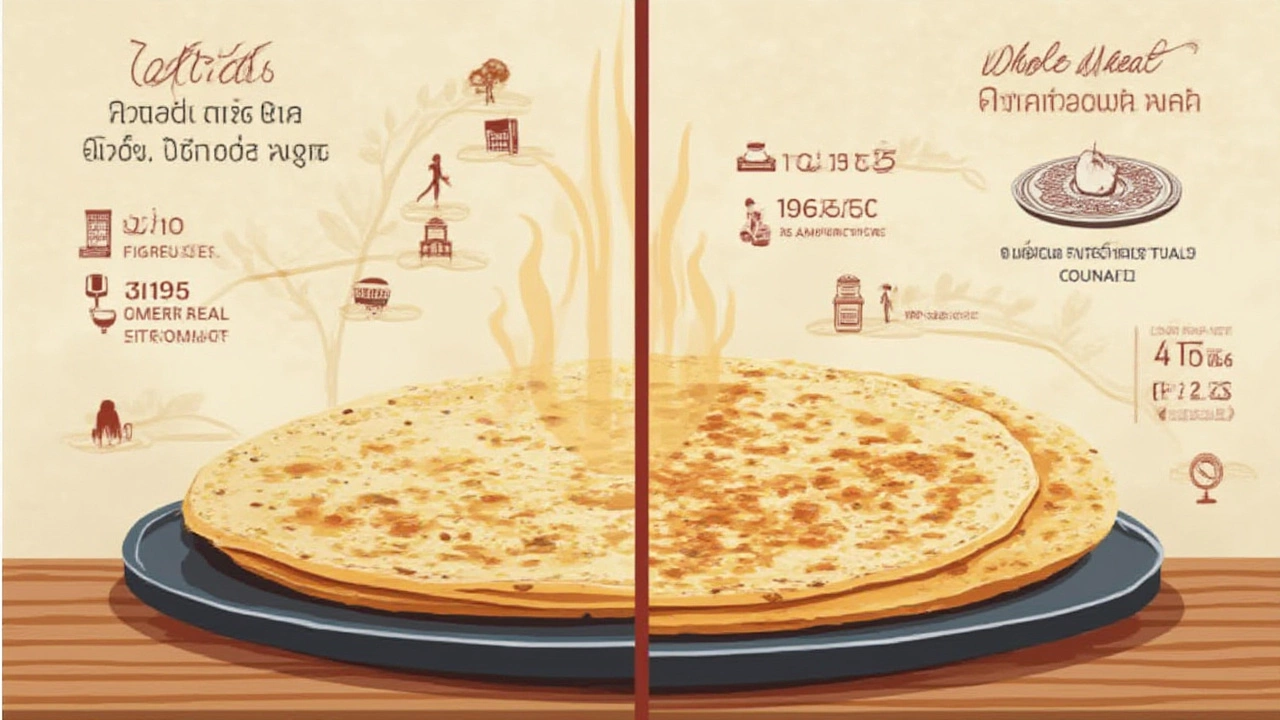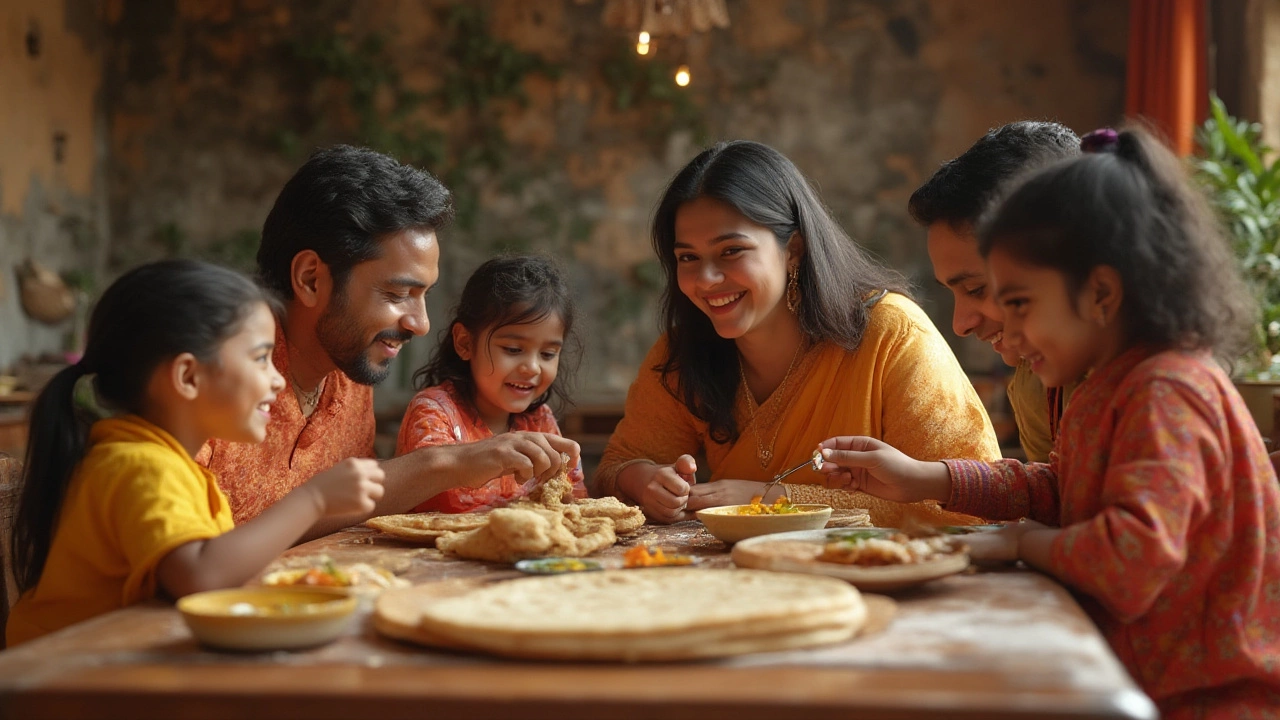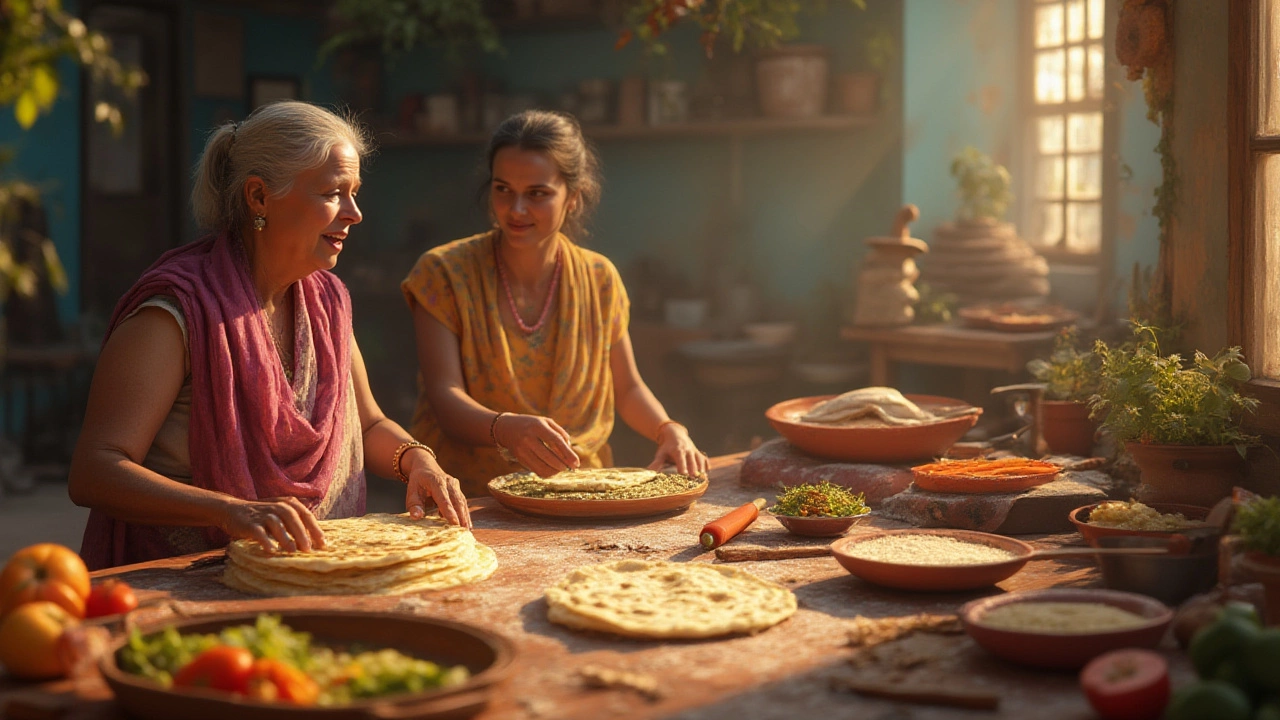Here’s something you probably haven’t heard at a family dinner: Roti and chapati are supposed to be different, even though we’ve been using their names like twins forever. The question pops up in kitchens and cafes, at dinner with friends, at work over lunchboxes—does it really matter which one you choose? When it comes to picking the healthier option, things get weirdly complicated. Is it all about the flour? Are the differences mostly about how they’re cooked? Or is it just a classic food myth that makes us second-guess our meal choices?
The Big Debate: What Sets Roti and Chapati Apart?
First off, let’s clear up the confusion. In homes across India and even among foodies abroad, roti and chapati often mean the same thing. But that’s only half the truth. While both are unleavened flatbreads made with whole wheat flour (called atta), there's a little twist in the tale. Chapati is typically rolled out thinner and cooked directly on a dry hot tawa (griddle). There’s no oil or fat involved. Roti sometimes refers broadly to any kind of Indian flatbread, but in practice, it’s usually thicker, perfect for puffing up over an open flame or a tandoor, and sometimes brushed with ghee or oil.
So what does this mean for the texture and taste? Chapati comes out softer and lighter, perfect for scooping up curry and vegetables without feeling like you ate a brick. Roti’s thicker, sometimes heartier, and if it’s brushed with ghee, there are extra calories creeping in. When you walk into a North Indian kitchen, it’s common to find rotis being made thick for some meals, and chapatis rolled out paper-thin for others depending on what’s on the menu. Down south or in Mumbai, the words get swapped even more freely, so don’t be surprised if vendors hand you ‘chapatis’ that look exactly like what your grandma calls ‘roti.’
Now, here’s an interesting fact: the word ‘chapati’ comes from the Hindi word ‘chapat,’ which literally means to slap — as some folks shape chapati by slapping the dough between their hands. ‘Roti’ just means bread, but who knew a humble flatbread could create so much drama at the dinner table? In the end, the difference boils down to thickness, cooking method, and sometimes what gets slathered on top. Sounds simple, right? Not so fast—wait till you hear what goes into each one.

Breaking Down the Nutritional Details
Let’s get nerdy for a minute. Both roti and chapati are usually made with 100% whole wheat flour, and that’s actually a big deal. Whole wheat means you’re getting the bran, the germ, and the endosperm. That’s dietary fiber, protein, and a decent load of B-vitamins and minerals like iron and magnesium all packed into a single flatbread. Here’s where things start to tilt: It’s all about what you add or skip during cooking and how thick that dough gets rolled out.
If you’re making chapati at home, you basically just knead flour with water and maybe a pinch of salt. Roll it out thin, slap it onto a hot tawa, give it a quick flip, and you’re done. Unless you sneak in a swipe of ghee on top, your chapati stays super low in fat, with one medium-sized piece clocking in around 70-80 calories, 3 grams of protein, and 2-3 grams of fiber. Thicker rotis—especially if you touch them up with ghee after cooking—will tip the calorie and fat count upwards. Just adding a simple teaspoon of ghee can add about 45 extra calories and 5 grams of fat.
Let’s put things side by side for a quick look:
| Nutrient | Chapati (1 medium, 35g) | Roti (1 thick, 45g, with ghee) |
|---|---|---|
| Calories | 75 | 130 |
| Protein (g) | 3.1 | 3.5 |
| Fiber (g) | 2.9 | 3.7 |
| Total Fat (g) | 0.5 | 6.0 |
| Carbohydrates (g) | 15.0 | 20.0 |
It’s pretty clear: the basic chapati is lighter, while thicker or ghee-brushed rotis pack more calories and fat. But there’s more to health than calories, right? Glycemic index is another word foodies and doctors love to throw around. Both chapati and roti rank much lower than white rice, but chapatis tend to have a tiny edge—they’re thinner, so your body digests them slower, leading to a steadier energy release. That means you’re less likely to wolf down the whole meal and feel sleepy right after.
There’s a neat tip here: those with diabetes or trying to lose weight should go for thin chapatis, and skip the ghee or butter. Want to bump up the nutrients? Slip in some ground flaxseed, add chopped spinach, or try a 50-50 mix of wheat flour with gram (chana) flour. These little tweaks give you a vitamin and fiber punch that’s hard to beat.
While we’re on the subject, hydration matters too. Chapati dough needs a generous splash of water, making the bread stay soft for longer. If you’re packing lunch for work or a road trip, chapatis often survive in the tiffin box without turning chewy. Rotis sometimes dry out, so they tend to be tastier steamed right out of the pan—and they’re perfect at a sit-down dinner.
Don’t forget about portion control. Nobody goes to bed happy after six rotis or chapatis. Most nutritionists suggest two small to medium servings per meal paired with dal, sabzi, or lean proteins. If you’re following a low-carb diet, you might want to try swapping half your wheat flour for almond or soybean flour—keeps the carbs in check, while boosting protein.

Which Should You Pick: Roti or Chapati?
If you ask your grandmother, she’ll probably say it doesn’t matter as long as you eat what’s made with love. But friend groups, fitness coaches, and dietitians these days look a lot closer at the details. Want something softer, lighter, and easier to digest? Chapati wins the round. Its lighter recipe and absence of fat make it the go-to for weight-watchers and diabetics.
That being said, thick, fluffy rotis brushed with a bit of ghee have their own place, especially for kids, hard workers, or folks who need a bit more energy during the day. If your day is packed with meetings, errands, and workout sessions, a heartier roti can keep you going. For elderly folks, chapatis—with their softer bite and easier digestion—are usually the better call.
If you’re after variety, get playful. Add a sprinkle of ajwain (carom seeds) for a tangy, gut-friendly chapati. Or stuff rotis with mashed potatoes, paneer, or greens for a wholesome meal in itself. Gluten intolerant? Try bajra (pearl millet) or jowar (sorghum) flour as a swap—they don’t taste exactly the same, but they’re packed with minerals and are easier on the stomach. Health trend alert: nutrition gurus now love ‘multigrain’ rotis loaded with oats, quinoa, and seeds, so don’t be afraid to experiment in your own kitchen.
People always ask if roti or chapati is flat-out ‘healthier’, but the real answer is, it depends on how you make and eat them. At its plainest, chapati clocks in lower in calories and fat—so it’s technically more diet-friendly. Roti, when loaded with extras or made thick, brings extra nutrients and calories that work better for active bodies who burn them off.
And here’s something you won’t find on most food blogs: the act of making these breads by hand—kneading, rolling, and cooking—keeps you connected to your food, and that sometimes matters just as much as calorie counts. If tradition is part of your daily routine, mixing up roti and chapati is part of what makes the Indian food experience so real and personal.
When you’re staring at the hot tawa, wondering which one to go for, ask yourself how hungry you are, what’s on your health agenda, and how much time you have. Thin, soft chapati for a light, healthy bite. Thick, hearty roti with a little ghee for when you need that extra kick. Both can be healthy—so the best pick is the one you make yourself, fresh and tailored for your mood. No need to let the bread basket stress you out at dinner—after all, at the end of the day, both choices are rooted in centuries of tradition (and pretty much always taste better with good company).
